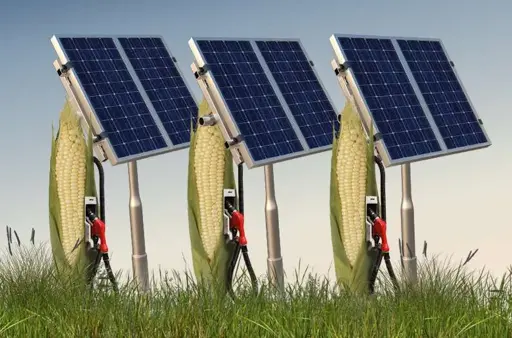Corn gets a ton of subsidized funding, it sure would be nice if all that funding went to green energy instead.
I mean if you think about it, what is a corn field but a really shitty solar panel?
To be fair, cornfields consume resources other than solar energy. Like CO2. However the benefits of consuming CO2 goes away if you’re just gonna burn the corn, which releases CO2 again.
to give a visual indication of that comparison:
ha
vs.
ha ha ha ha ha ha ha ha ha ha ha ha ha ha ha ha ha ha ha ha ha ha ha ha ha ha ha ha ha ha ha
Idk man solar might be better but the corn sounds a lot funnier.
But you can’t pour solar panels into a fuel tank. What liquid biofuels are good for is stuff you can’t electrify, like aviation and shipping.
There’s multiple companies working on electric passenger planes, and smaller cargo ships.
Sure, but the context is that the US dedicates almost half its corn crop to ethanol that’s blended with gasoline. Vehicle electrification + solar panels will free up a huge amount of agricultural land.

I didn’t know solar panels could laugh.
I’m surprised that the difference is apparently that low considering the efficiency of photosynthesis vs the photovoltaic effect, the fact that not all of the plant gets turned into ethanol, and the efficiency of the combustion process.
deleted by creator
Ha? The tv comedy network?
We’ve got to strengthen our knees!
How many ha of solar panels to produce the lifetime output of a 4,000 MW Nuclear power plant? (~45 years)
Don’t compare nuclear and renewables, compare both to fossil fuels and greenwashing garbage like biomass and bio ethanol.
Is bio ethanol bad?
It’s bad because it uses tons of space and resources that could be used for other things. It also promotes mono culture and it usually uses fertilizers and pesticides that are not necessarily allowed on other crops, as they won’t be used as feed.
So, it’s bad for biodiversity, bad for land use, bad for resource use. The upside of being a low carbon fuel is completely offset by the impact it has on nature.The thing with biofuels is that they could be used to feed people instead
Yes, really really bad.
How many 4000MW nuclear power plants have been stood up in the last 10 years? What is their total generating wattage/dollar?
To give you a hand, none have been built in the US in that time. The closest ones are the Vogel powerplants in Georgia, and each of them is just 1200MW. They were also something like 17 billion over budget and 7 years late. Local residents are facing a permanent extra $15/month fee just to pay for building them.
Now look at solar. We stood up a 1400MW Gemini solar plant in Nevada in 2 years from paperwork to inception, at a cost of 2 billion dollars. It includes solar and batteries. It won’t give you 24hr steadystate, but properly built, you could indeed make it run “24/7” at 1000MW by adding about 16hr of battery and 2x-3x the panels. This would still cost less and be built way, way faster than even 1 Vogle nuclear plant.
Commodity solar and battery are here and already beating solar while their tech just gets better. Why would we build antiquated, large nuclear plants at this point at all?
4,000MW / 400w per panel = 10,000,000 panels, or about 3,444 acres of solar panels. That’s about the size of a small-ish town, and 75x larger than an equivalently rated nuclear plant.
However, the initial and maintenance costs of so many solar panels are far lower than those of nuclear, or at least they were before Orange Monday.
Except that that solar farm doesn’t produce energy at night, so you’d need batteries to smooth out the power. If you used lead acid batteries because they are highly recyclable, you’re looking at 2.4 million tonnes of batteries for a 24 hour backup, and they need to be replaced once every 30 years(however more likely 10 years since such a battery backup would be used in a cycling application), and the 4GW nuclear power plant will put out close to 4GW all the time but the solar farm will only produce 4GW of energy for about an hour a day, so you’d need a 20GW solar plant to produce continuous energy equivalent to a 4GW nuclear plant in conditions like northern Europe or the northern US.
Other battery chemistries can be used, but have trade-offs in recyclability, availability, and materials required – for the lead acid batteries you need lead, sulphuric acid, and some form of plastic, but for other batteries you need exotic materials which are much more difficult to acquire.
Scale and intermittency screw up all the math and nobody really considers those factors. It’s fine for a single household which lives based on what is available at the moment, but industrial scale breaks a lot of things – like ethanol fuels.
That’s where base load generation like hydroelectric or geothermal are highly beneficial, because they work 24/7/365 and don’t need to be oversized and don’t need massive storage solutions. There is a legitimate criticism that they aren’t available everywhere, but the reality is that environment was in has to be local, and so you have to make use of the resources that are available. If there isn’t enough generating capacity in a region for a bunch of people, they’re probably just shouldn’t be that many people there you want to be in equilibrium with nature.
Nobody is arguing against nuclear, shut the fuck up. Live in the real world where we are needing to slowly make progress on nuclear again because of morons who can’t accept chernobyl isn’t going to happen again.
I’m generally pro nuclear, and potential chornobyl is less worrisome to me than a potential Zaporizhzhia.
4GW per hour, 24 hours a day would be 96GWh per day.
One statistic I found said that it takes 2.97 acres to make 1GWh of power over a year. Converting that to GWh per day per acre gives me 0.000922.
Dividing the 96GWh by 0.000922 gives me ~104,121.48 acres or ~402 sq. miles.




